XMM-Newton News Archive 2014 - XMM-Newton
XMM-Newton News Archive - Year 2014
Back to News Archive.

Millón y medio de segundos dedicados a la caza de la materia oscura
La materia oscura es la más abundante en el universo, y aún así sigue siendo una gran desconocida. Nunca ha sido detectada directamente, pues es por ahora invisible, y de ella solo se sabe que su fuerza de gravedad influye en el resto de objetos del universo. El telescopio espacial de rayos X de la ESA, XMM-Newton, ha anunciado que uno de sus principales retos para el próximo año será la búsqueda de esta materia con un programa de observación de casi 1.4 millones de segundos.
Further details on ESA's Spanish pages.
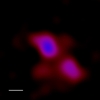
XMM-Newton spots monster black hole hidden in tiny galaxy
First impressions can be deceptive â astronomers have used ESA's X-ray satellite XMM-Newton to find a massive black hole hungrily feeding within a tiny dwarf galaxy, despite there being no hint of this black hole from optical observations.
Further details on ESA's Science & Technology pages.

Magnetar discovered close to supernova remnant Kesteven 79
Massive stars end their life with a bang, exploding as supernovas and releasing massive amounts of energy and matter. What remains of the star is a small and extremely dense remnant: a neutron star or a black hole.
Further details on ESA's Space in Images pages.
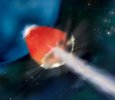
Bizarre nearby blast mimics Universe's most ancient stars
ESA's XMM-Newton observatory has helped to uncover how the Universe's first stars ended their lives in giant explosions. Astronomers studied the gamma-ray burst GRB130925A using space- and ground-based observatories.
Further details on ESA's Space Science pages and on ESA's Science & Technology pages.
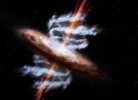
Athena to study the hot and energetic Universe
ESA has selected the Athena advanced telescope for high-energy astrophysics as its second 'Large-class' science mission. The observatory will study the hot and energetic Universe and takes the 'L2' slot in ESA's Cosmic Vision 2015â25 plan, with a launch foreseen in 2028.
Further details on ESA's Science & Technology pages.

Award for European scientist who solved a magnetic mystery
The Committee on Space Research (COSPAR) and the Russian Academy of Sciences have nominated Nanda Rea, an assistant professor at the Institute of Space Sciences (CSIC-IEEC) in Barcelona and the Anton Pannekoek Institute (API) at the University of Amsterdam, for a prestigious Zeldovich Medal.
Further details on ESA's Science & Technology pages.
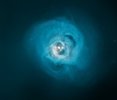
Puzzling X-rays point to dark matter
Astronomers using ESA and NASA high-energy observatories have discovered a tantalising clue that hints at an elusive ingredient of our Universe: dark matter.
Further details on ESA's Space Science pages.
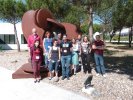
SAS Workshop 2014: Learning to see with X-ray vision
The XMM-Newton Science Analysis System (SAS) Workshop has been an annual event at ESAC since 2000. Its aim is to help XMM-Newton users to learn how to manipulate and analyse XMM-Newton data.
Further details on the XMM-Newton SOC pages.
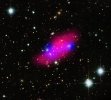
Cosmic collision in the Bullet Group
Galaxies are not as isolated as they at first glance may seem; on a cosmic scale they congregate in clumps along with dark matter and hot gas. The colourful blob in this new composite image, based on data from several telescopes including ESA's XMM-Newton, is the group of galaxies known as the Bullet Group.
Further details on ESA's Science & Technology pages.

Pulsating X-rays allow XMM-Newton to unmask a mysterious star
XMM-Newton has revealed a unique star. It is a celestial chimera with the body of a normal massive star yet the magnetic field of a dead, stellar dwarf. This makes it a singular object among the billions of known stars.
Further details on ESA's Science & Technology pages.
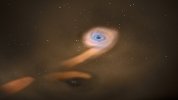
Unique pair of hidden black holes discovered by XMM-Newton
A pair of supermassive black holes in orbit around one another have been spotted by XMM-Newton. This is the first time such a pair have been seen in an ordinary galaxy. They were discovered because they ripped apart a star when the space observatory happened to be looking in their direction.
Further details on ESA's Science & Technology pages.
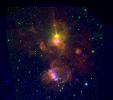
Star-forming region ON2
Massive stars are born in tumultuous clouds of gas and dust. They lead a brief but intense life, blowing powerful winds of particles and radiation that strike their surroundings, before their explosive demise as supernovas. The interplay between massive stars and their environment is revealed in this image of the star-forming region ON2. It combines X-ray coverage from ESA's XMM-Newton X-ray observatory with an infrared view from NASA's Spitzer Space Telescope.
Further details on ESA's Space in Images portal.

XMM-Newton reveals a candidate period for the spin of the "Magnificent Seven" neutron star RX J1605.3+3249
The "Magnificent Seven" is a group of thermal X-ray emitting isolated neutron stars whose properties are closer to magnetars than classical rotationally powered pulsars. To date, rotational periods have been determined for all but RX J1605+3249. This paper reports the XMM-Newton successful detection of pulsed emission, a period of 3.38 sec, and evidence of a spindown that implies a dipole field of about 7 x 1013G.
Further details on the Astronomy & Astrophysics portal.
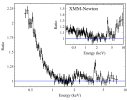
Chandra and XMM-Newton Provide Direct Measurement of Distant Black Hole's Spin
Astronomers have used NASA's Chandra X-ray Observatory and the European Space Agency's (ESA's) XMM-Newton to show a supermassive black hole six billion light years from Earth is spinning extremely rapidly. This first direct measurement of the spin of such a distant black hole is an important advance for understanding how black holes grow over time.
Further details on the Chandra X-ray Observatory pages.
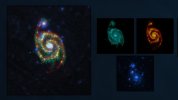
The whirl of stellar life
The Whirlpool Galaxy, also known as M51 or NGC 5194, is one of the most spectacular examples of a spiral galaxy. With two spiral arms curling into one another in a billowing swirl, this galaxy hosts over a hundred billion stars and is currently merging with its companion, the smaller galaxy NGC 5195.
Further details on the Space in Images pages.
- Removed a total of (1) style text-align:center;








































 Sign in
Sign in
 Science & Technology
Science & Technology